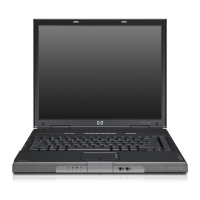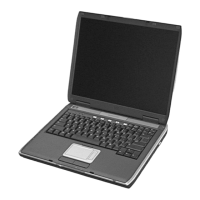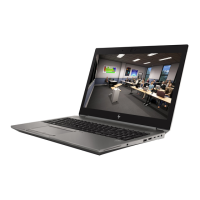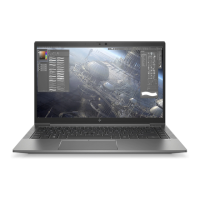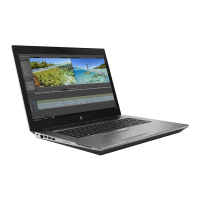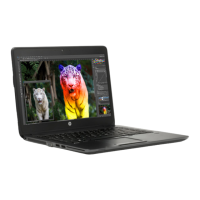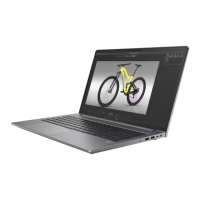Do you have a question about the HP ze2000 and is the answer not in the manual?
Identifies and describes the primary components on the notebook's top surface.
Details the function and types of keys on the keyboard.
Explains the TouchPad and its associated buttons and scrolling region.
Describes the notebook's power and standby buttons and display switch.
Identifies and explains the various indicator lights on the notebook.
Details the function of wireless and volume control buttons.
Describes the location and function of wireless antennae.
Identifies and explains components located on the front of the notebook.
Explains audio output, input jacks, and the display release mechanism.
Identifies and describes components located on the rear of the notebook.
Details ports and jacks found on the left side of the notebook.
Explains the PC Card slot and its eject button.
Identifies and describes components found on the right side of the notebook.
Details the Mini PCI and memory compartments on the notebook's bottom.
Describes the battery and hard drive bays, latch, and vents.
Lists and describes standard external components like adapters and cables.
Explains the contents and use of software on optical discs.
Describes the information provided by labels affixed to the notebook.
Details the TouchPad and its components.
Explains how to use the TouchPad for navigation, selection, and scrolling.
Describes how to adjust TouchPad settings and preferences.
Introduces hotkeys and how to identify them on the keyboard.
Provides a quick lookup table for default hotkey functions.
Explains the methods for activating hotkey commands.
Details specific hotkey functions like Help and Support.
Discusses the use of embedded and external numeric keypads.
Explains how to use the notebook's built-in numeric keypad.
Describes how to activate and deactivate the embedded numeric keypad.
Explains how to temporarily switch between standard and keypad functions.
Discusses the use of external numeric keypads.
Guides users on choosing the best power source for their tasks.
Details how the notebook manages power from battery and AC sources.
Identifies power controls and indicator lights on the notebook.
Provides an overview of standby, hibernation, and shutdown modes.
Explains the standby mode for power saving and quick resume.
Describes the hibernation mode for deeper power saving.
Offers advice on how to save and manage work before leaving the notebook.
Warns about potential interference when using media during power states.
Outlines the steps for turning the notebook on, off, and managing power states.
Details how to enter and exit standby mode.
Explains how to start and resume from hibernation.
Provides methods for shutting down the notebook if it becomes unresponsive.
Covers managing power usage and settings.
Describes how to set a password to protect the notebook during standby.
Allows customization of power button and hotkey functions.
Discusses battery management and charging.
Provides instructions for charging the notebook's battery pack.
Explains how to check the battery's charge status and accuracy.
Details how to view battery charge information on the screen.
Explains alerts and system responses for low battery levels.
Describes what happens when the battery reaches low or critical levels.
Offers solutions for handling low battery situations.
Explains when and how to calibrate the battery for accuracy.
Offers tips to maximize battery life.
Guides users on how to safely replace the notebook battery.
Step-by-step instructions for removing the battery pack.
Step-by-step instructions for installing a battery pack.
Provides advice on storing the battery pack when not in use.
Explains proper disposal methods for used battery packs.
Describes the notebook's built-in stereo speakers and their function.
Explains how to adjust volume using buttons and software.
Details connecting external audio devices like headphones and speakers.
Describes how to connect a microphone via the audio-in jack.
Covers connecting external video sources.
Details how to switch and display video images on different screens.
Covers inserting, removing, and playing discs.
Explains hotkeys for controlling media playback.
Describes how to configure the notebook's response to inserting discs.
Offers advice to ensure smooth playback and disc writing.
Warns against unauthorized copying of copyrighted material.
Lists and describes multimedia software included with the notebook.
Guides on how to install software from a CD.
Explains how to enable or disable the AutoPlay feature.
Details how to adjust DVD region codes for playback compatibility.
Introduces wireless capabilities like 802.11 and Bluetooth.
Explains the wireless button and lights for managing wireless devices.
Describes 802.11 wireless standards and their implementations.
Guides on configuring a wireless local area network at home.
Explains how to connect the notebook to a home WLAN.
Details how to connect to wireless networks in public places.
Covers essential security measures for wireless networks.
Helps identify the specific 802.11 wireless device installed.
Provides guidance for resolving wireless device issues.
Describes Bluetooth wireless capabilities and functions.
Explains how to manage power states for wireless devices.
Guides on how to turn on wireless devices using the button or utility.
Explains how to turn off and disable wireless devices.
Introduces security measures to protect the computer and data.
Explains the QuickLock feature for securing the system during log on.
Details the differences and management of setup and Windows passwords.
Discusses how to manage different types of passwords effectively.
Provides guidelines for selecting strong passwords.
Describes the administrator password for accessing the Setup utility.
Guides on how to set, change, or delete the administrator password.
Explains how to enter the administrator password.
Details the power-on password to prevent unauthorized computer access.
Guides on how to set, change, or delete the power-on password.
Explains how to enter the power-on password.
Covers disabling or enabling system devices via the Setup utility.
Discusses the importance and use of antivirus software.
Emphasizes the need for regular Windows security updates.
Explains the role of firewall software in protecting privacy.
Describes how to install and use a security cable for physical protection.
Provides general instructions for connecting external devices.
Details how to connect and disconnect powered external devices.
Explains how to connect various USB devices to the notebook.
Guides on connecting IEEE 1394 devices like cameras and scanners.
Covers connecting modems and setting up internet service.
Lists supported digital memory card types.
Explains the function of the Digital Media Slot indicator light.
Provides instructions for inserting memory cards.
Guides on safely removing memory cards.
Explains PC Cards and their compatibility.
Details how to insert a PC Card into the slot.
Guides on safely removing a PC Card.
Covers adding and caring for storage drives.
Describes the IDE drive activity indicator light.
Step-by-step guide for replacing the internal hard drive.
Discusses memory modules and upgrades.
Guides on upgrading the notebook's RAM.
Step-by-step instructions for handling memory modules.
Emphasizes the importance of keeping software up-to-date.
Details information needed before performing software updates.
Explains how to find product details for updates.
Guides on how to check the current ROM version.
Covers the process of downloading and installing software updates.
Provides specific instructions for ROM update procedures.
Details how to find and download ROM updates from HP.
Explains how to install a downloaded ROM update.
Guides on downloading and installing other software updates.
Discusses system recovery options.
Explains how to use System Restore to revert system changes.
Guides on creating manual restore points.
Details how to restore the system to a previous state.
Covers steps for repairing or reinstalling software and drivers.
Introduces the Setup utility for system configuration.
Explains how to access the computer's BIOS/Setup utility.
Guides on changing the language used in the Setup utility.
Explains how to navigate and make selections within the Setup utility.
Details how to view system information within the Setup utility.
Guides on resetting Setup utility settings to defaults.
Covers advanced features and options available in the Setup utility.
Explains how to exit the Setup utility with or without saving changes.
Provides environmental specifications for operating and non-operating conditions.
Details the electrical power specifications for the notebook.
Lists the signals supported by the notebook's expansion port.
Identifies and describes the primary components on the notebook's top surface.
Details the function and types of keys on the keyboard.
Explains the TouchPad and its associated buttons and scrolling region.
Describes the notebook's power and standby buttons and display switch.
Identifies and explains the various indicator lights on the notebook.
Details the function of wireless and volume control buttons.
Describes the location and function of wireless antennae.
Identifies and explains components located on the front of the notebook.
Explains audio output, input jacks, and the display release mechanism.
Identifies and describes components located on the rear of the notebook.
Details ports and jacks found on the left side of the notebook.
Explains the PC Card slot and its eject button.
Identifies and describes components found on the right side of the notebook.
Details the Mini PCI and memory compartments on the notebook's bottom.
Describes the battery and hard drive bays, latch, and vents.
Lists and describes standard external components like adapters and cables.
Explains the contents and use of software on optical discs.
Describes the information provided by labels affixed to the notebook.
Details the TouchPad and its components.
Explains how to use the TouchPad for navigation, selection, and scrolling.
Describes how to adjust TouchPad settings and preferences.
Introduces hotkeys and how to identify them on the keyboard.
Provides a quick lookup table for default hotkey functions.
Explains the methods for activating hotkey commands.
Details specific hotkey functions like Help and Support.
Discusses the use of embedded and external numeric keypads.
Explains how to use the notebook's built-in numeric keypad.
Describes how to activate and deactivate the embedded numeric keypad.
Explains how to temporarily switch between standard and keypad functions.
Discusses the use of external numeric keypads.
Guides users on choosing the best power source for their tasks.
Details how the notebook manages power from battery and AC sources.
Identifies power controls and indicator lights on the notebook.
Provides an overview of standby, hibernation, and shutdown modes.
Explains the standby mode for power saving and quick resume.
Describes the hibernation mode for deeper power saving.
Offers advice on how to save and manage work before leaving the notebook.
Warns about potential interference when using media during power states.
Outlines the steps for turning the notebook on, off, and managing power states.
Details how to enter and exit standby mode.
Explains how to start and resume from hibernation.
Provides methods for shutting down the notebook if it becomes unresponsive.
Covers managing power usage and settings.
Describes how to set a password to protect the notebook during standby.
Allows customization of power button and hotkey functions.
Discusses battery management and charging.
Provides instructions for charging the notebook's battery pack.
Explains how to check the battery's charge status and accuracy.
Details how to view battery charge information on the screen.
Explains alerts and system responses for low battery levels.
Describes what happens when the battery reaches low or critical levels.
Offers solutions for handling low battery situations.
Explains when and how to calibrate the battery for accuracy.
Offers tips to maximize battery life.
Guides users on how to safely replace the notebook battery.
Step-by-step instructions for removing the battery pack.
Step-by-step instructions for installing a battery pack.
Provides advice on storing the battery pack when not in use.
Explains proper disposal methods for used battery packs.
Describes the notebook's built-in stereo speakers and their function.
Explains how to adjust volume using buttons and software.
Details connecting external audio devices like headphones and speakers.
Describes how to connect a microphone via the audio-in jack.
Covers connecting external video sources.
Details how to switch and display video images on different screens.
Covers inserting, removing, and playing discs.
Explains hotkeys for controlling media playback.
Describes how to configure the notebook's response to inserting discs.
Offers advice to ensure smooth playback and disc writing.
Warns against unauthorized copying of copyrighted material.
Lists and describes multimedia software included with the notebook.
Guides on how to install software from a CD.
Explains how to enable or disable the AutoPlay feature.
Details how to adjust DVD region codes for playback compatibility.
Introduces wireless capabilities like 802.11 and Bluetooth.
Explains the wireless button and lights for managing wireless devices.
Describes 802.11 wireless standards and their implementations.
Guides on configuring a wireless local area network at home.
Explains how to connect the notebook to a home WLAN.
Details how to connect to wireless networks in public places.
Covers essential security measures for wireless networks.
Helps identify the specific 802.11 wireless device installed.
Provides guidance for resolving wireless device issues.
Describes Bluetooth wireless capabilities and functions.
Explains how to manage power states for wireless devices.
Guides on how to turn on wireless devices using the button or utility.
Explains how to turn off and disable wireless devices.
Introduces security measures to protect the computer and data.
Explains the QuickLock feature for securing the system during log on.
Details the differences and management of setup and Windows passwords.
Discusses how to manage different types of passwords effectively.
Provides guidelines for selecting strong passwords.
Describes the administrator password for accessing the Setup utility.
Guides on how to set, change, or delete the administrator password.
Explains how to enter the administrator password.
Details the power-on password to prevent unauthorized computer access.
Guides on how to set, change, or delete the power-on password.
Explains how to enter the power-on password.
Covers disabling or enabling system devices via the Setup utility.
Discusses the importance and use of antivirus software.
Emphasizes the need for regular Windows security updates.
Explains the role of firewall software in protecting privacy.
Describes how to install and use a security cable for physical protection.
Provides general instructions for connecting external devices.
Details how to connect and disconnect powered external devices.
Explains how to connect various USB devices to the notebook.
Guides on connecting IEEE 1394 devices like cameras and scanners.
Covers connecting modems and setting up internet service.
Lists supported digital memory card types.
Explains the function of the Digital Media Slot indicator light.
Provides instructions for inserting memory cards.
Guides on safely removing memory cards.
Explains PC Cards and their compatibility.
Details how to insert a PC Card into the slot.
Guides on safely removing a PC Card.
Covers adding and caring for storage drives.
Describes the IDE drive activity indicator light.
Step-by-step guide for replacing the internal hard drive.
Discusses memory modules and upgrades.
Guides on upgrading the notebook's RAM.
Step-by-step instructions for handling memory modules.
Emphasizes the importance of keeping software up-to-date.
Details information needed before performing software updates.
Explains how to find product details for updates.
Guides on how to check the current ROM version.
Covers the process of downloading and installing software updates.
Provides specific instructions for ROM update procedures.
Details how to find and download ROM updates from HP.
Explains how to install a downloaded ROM update.
Guides on downloading and installing other software updates.
Discusses system recovery options.
Explains how to use System Restore to revert system changes.
Guides on creating manual restore points.
Details how to restore the system to a previous state.
Covers steps for repairing or reinstalling software and drivers.
Introduces the Setup utility for system configuration.
Explains how to access the computer's BIOS/Setup utility.
Guides on changing the language used in the Setup utility.
Explains how to navigate and make selections within the Setup utility.
Details how to view system information within the Setup utility.
Guides on resetting Setup utility settings to defaults.
Covers advanced features and options available in the Setup utility.
Explains how to exit the Setup utility with or without saving changes.
Provides environmental specifications for operating and non-operating conditions.
Details the electrical power specifications for the notebook.
Lists the signals supported by the notebook's expansion port.
| Memory | Up to 2GB DDR |
|---|---|
| Optical Drive | DVD+/-RW |
| Operating System | Windows XP Home or Windows XP Professional |
| Battery Life | Up to 3 hours |
| Ports | 3 USB 2.0, VGA, headphone, microphone |
| Wireless | 802.11b/g |
| Graphics | ATI Radeon Xpress 200M (integrated) |
